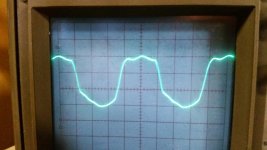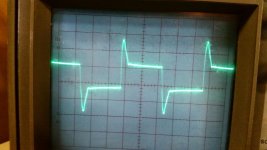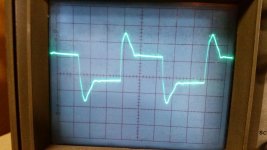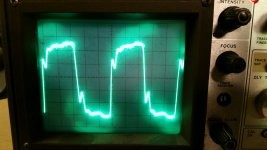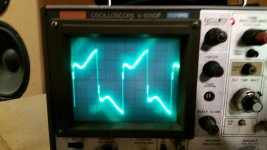As you told 10KHz square waves are not perfect,any idea to clean it?
Check out the link to my video from the previous post. The square waves are looking better, but still not perfect. I'm ordering a dummy load resistor this week to check it against a true 8-ohm load which should help me avoid some of the messy impedance from my crappy shop speakers.
I'll report more soon.
Kofi
Kofi,
Check the 10kHz square wave at the output tube grids.
What you need to find out is if that underdamped response is a function of the front end or an interaction between power tubes and the output tranny.
If the later then a zobel (conjunctive filter or whatever you want to call it) of series cinnected 1K and say 2.7nF wired between anode and screen connections of the output tranny (1 for each side) would be the next thing to try.
I arrived at these values by the following method:
Raa = 6K6, The primary winding (turns) ratios anode to screen : screen to CT : CT to screen : screen to anode ared 0.3 : 0.2 : 0.2 :0.3 (For 40% U/L).
The zobels go anode to screen tap so that is 0.3 of turns for each side.
Coz impedance ratio is the square of turns ratio then the impedance of the anode to screen sections is 6K6 x (0.3 ^2) = 594 Ohms
For a Zobel you want the resistor to be 1.4 to 2 x that 594 Ohms
i.e. between 831 and 1188 Ohms.
So use 1K
The ringing looks like it is about 60kHz (about 3 rings on each side of the 10kHz square wave).
So 2 x pi x frequency = 377,000 and that = 1/(R x C) Note: R x C is called the Timeconstant
Take 1 on that to give the Timeconstant of = 2.65 x 10^-6 then divide by the R = 1K to get the C (2.7 nF).
If this cures the ringing you can try lower value caps (2n2, 1n5 etc).
Ideally you want to see a slight overshoot on the leading edge with no ringing.
Of-course if the ringing is observed at the output tube grids then all this can be ignored.
Cheers,
Ian
Check the 10kHz square wave at the output tube grids.
What you need to find out is if that underdamped response is a function of the front end or an interaction between power tubes and the output tranny.
If the later then a zobel (conjunctive filter or whatever you want to call it) of series cinnected 1K and say 2.7nF wired between anode and screen connections of the output tranny (1 for each side) would be the next thing to try.
I arrived at these values by the following method:
Raa = 6K6, The primary winding (turns) ratios anode to screen : screen to CT : CT to screen : screen to anode ared 0.3 : 0.2 : 0.2 :0.3 (For 40% U/L).
The zobels go anode to screen tap so that is 0.3 of turns for each side.
Coz impedance ratio is the square of turns ratio then the impedance of the anode to screen sections is 6K6 x (0.3 ^2) = 594 Ohms
For a Zobel you want the resistor to be 1.4 to 2 x that 594 Ohms
i.e. between 831 and 1188 Ohms.
So use 1K
The ringing looks like it is about 60kHz (about 3 rings on each side of the 10kHz square wave).
So 2 x pi x frequency = 377,000 and that = 1/(R x C) Note: R x C is called the Timeconstant
Take 1 on that to give the Timeconstant of = 2.65 x 10^-6 then divide by the R = 1K to get the C (2.7 nF).
If this cures the ringing you can try lower value caps (2n2, 1n5 etc).
Ideally you want to see a slight overshoot on the leading edge with no ringing.
Of-course if the ringing is observed at the output tube grids then all this can be ignored.
Cheers,
Ian
Last edited:
Ian,
Sorry I'm so late in thanking you for your awesome post. Very VERY helpful.
I've noticed that sometimes I don't receive notifications of new replies in my E-mail, which is the case here.
Anyway, thanks again. I'll be able to look into this more on Saturday morning.
Kofi
Sorry I'm so late in thanking you for your awesome post. Very VERY helpful.
I've noticed that sometimes I don't receive notifications of new replies in my E-mail, which is the case here.
Anyway, thanks again. I'll be able to look into this more on Saturday morning.
Kofi
OK-- so, today I went out and pumped a little more voltage through the amp by maxing out the volume from the signal generator and the square wave changed to what you see below.
Could it be that I just didn't have the volume up enough? It looks like there's some 'notch distortion' here at the cutoff point, which I would expect from a push-pull amp without NFB, but also maybe some additional noise that could be cleaned up?
Maybe some NFB is warranted here?
Thoughts?
Kofi
Could it be that I just didn't have the volume up enough? It looks like there's some 'notch distortion' here at the cutoff point, which I would expect from a push-pull amp without NFB, but also maybe some additional noise that could be cleaned up?
Maybe some NFB is warranted here?
Thoughts?
Kofi
Attachments
OK-- bad news. My oscilloscope is busted. Note to all of you you might take your vintage o'scope to your eight-year-old's hands-on science fair:
DO NOT TAKE YOUR VINTAGE O'SCOPE TO YOUR EIGHT-YEAR-OLD'S HANDS-ON SCIENCE FAIR!!!
Anyway, I'll be bagging a new one of Ebay soon, but for now I am trying to track down an issue with monoblock #2.
Finished the second amp this afternoon and got the B+ spot on, however there is a HUGE hum and you can barely hear the amplified signal. Hum persists with the input signal disconnected.
Checking through the amp, the one noticeable difference between the first and second amps is that in the second one, the filaments are showing connectivity with ground while in the first one, the heaters are floating (and working).
I've pulled the filament connections off the PCB and I'm still getting connectivity to ground. I've looked through the amp pretty thoroghly and can't see why the filaments are referenced to ground. May be a stray wire somewhere...
I'm wiped out now, so I'll be investigating in the morning. Any guidance would be appreciated.
Ugh.
Kofi
DO NOT TAKE YOUR VINTAGE O'SCOPE TO YOUR EIGHT-YEAR-OLD'S HANDS-ON SCIENCE FAIR!!!
Anyway, I'll be bagging a new one of Ebay soon, but for now I am trying to track down an issue with monoblock #2.
Finished the second amp this afternoon and got the B+ spot on, however there is a HUGE hum and you can barely hear the amplified signal. Hum persists with the input signal disconnected.
Checking through the amp, the one noticeable difference between the first and second amps is that in the second one, the filaments are showing connectivity with ground while in the first one, the heaters are floating (and working).
I've pulled the filament connections off the PCB and I'm still getting connectivity to ground. I've looked through the amp pretty thoroghly and can't see why the filaments are referenced to ground. May be a stray wire somewhere...
I'm wiped out now, so I'll be investigating in the morning. Any guidance would be appreciated.
Ugh.
Kofi
First, the GOOD news:
1. I found the issue with the grounded heaters (a wire was pinned against the chassis by the power switch).
2. I found the issue with hum as well. Really REALLY stupid here-- i did not have the correct RCS jack plugged into the input.
Now the BAD news:
The amp hums and has RF interference (I can hear a radio station on the output) UNLESS the potentiometer is cranked all the way up. I am using a 50K pot-- maybe I should swap out the value? It also does not attenuate the signal completely, meaning that when the pot is completely turned down, I can still hear plenty of signal on the output.
I remember noticing that the square wave changed when I messed with the pot as well.
So, maybe my remaining issues are related to the pot value?
Kofi
1. I found the issue with the grounded heaters (a wire was pinned against the chassis by the power switch).
2. I found the issue with hum as well. Really REALLY stupid here-- i did not have the correct RCS jack plugged into the input.
Now the BAD news:
The amp hums and has RF interference (I can hear a radio station on the output) UNLESS the potentiometer is cranked all the way up. I am using a 50K pot-- maybe I should swap out the value? It also does not attenuate the signal completely, meaning that when the pot is completely turned down, I can still hear plenty of signal on the output.
I remember noticing that the square wave changed when I messed with the pot as well.
So, maybe my remaining issues are related to the pot value?
Kofi
Sure does sound nice when it's cranked, though:
Check it out here:
https://www.youtube.com/watch?v=-GTlLqIwNn4
Maybe a 10K pot would fare better and eliminate the hum at half volume?
Kofi
Check it out here:
https://www.youtube.com/watch?v=-GTlLqIwNn4
Maybe a 10K pot would fare better and eliminate the hum at half volume?
Kofi
OK-- just ordered a Tektronix 465B off Ebay to replace my old, broken clunker. Once it gets here I'm hoping I'll be able to track down my hum / oscillation issues.
So, I'm thinking I'll try to solder the gridstoppers right on the pns of the KT88s (they are currently on the PCB, so I'm thinking that may be contributing to some instability). I'll also look into beefing up the signal grounds and perhaps star-grounding them to the same single point on the chassis as the safety ground, rather than using the ground plane on the PCB.
Also, it looks like along with the hum I'm experiencing with the second monoblock I'm also seeing some vibration and additional heat from one of the power transformers. The heat / vibration of the power tranny is consistent and does not fluctuate with the hum when I move the pot to the halfway point.
I'll be investigating more this weekend. Anyone else ever experience this?
Kofi
So, I'm thinking I'll try to solder the gridstoppers right on the pns of the KT88s (they are currently on the PCB, so I'm thinking that may be contributing to some instability). I'll also look into beefing up the signal grounds and perhaps star-grounding them to the same single point on the chassis as the safety ground, rather than using the ground plane on the PCB.
Also, it looks like along with the hum I'm experiencing with the second monoblock I'm also seeing some vibration and additional heat from one of the power transformers. The heat / vibration of the power tranny is consistent and does not fluctuate with the hum when I move the pot to the halfway point.
I'll be investigating more this weekend. Anyone else ever experience this?
Kofi
OK-- added a 1K CC directly to the pins of the KT88 (for a 2K gridstopper in series) and... no change.
Rearranged the wiring and... no change.
Removed the 50K pot and replaced it with a 10K and-- HUM IS GONE!!!
Also, my o'scope came back to life (after ordering another one, of course), so I was able to look at the square waves again. Per gingertube's suggestion I tested the waveform bot at AND before the outputs and found that there is ringing on the leading edge coming directly from the input transformer.
I tried loading the transformer with some 1uF caps I had and it made a mess of the waveforms. I'm not using any NFB, but could I still load the input transformers with resistance to straighten it out?
Thoughts?
Kofi
Rearranged the wiring and... no change.
Removed the 50K pot and replaced it with a 10K and-- HUM IS GONE!!!
Also, my o'scope came back to life (after ordering another one, of course), so I was able to look at the square waves again. Per gingertube's suggestion I tested the waveform bot at AND before the outputs and found that there is ringing on the leading edge coming directly from the input transformer.
I tried loading the transformer with some 1uF caps I had and it made a mess of the waveforms. I'm not using any NFB, but could I still load the input transformers with resistance to straighten it out?
Thoughts?
Kofi
...your amps sounds nice...
They do sound nice, however there are a couple of issues.
First, the midrange and highs are a little "grainy", which I'm thinking may be what the improper square wave response is telling me. Pete mentioned that I might want to try to load the secondary of the input transformer with some resistance, so I'll give that a try to see if I can smooth things out.
Secondly, there is WAAAAAAYYYY too much gain. The amp can be driven into some rather nasty clipping with the volume pot about half-way around.
There's no negative feedback prescribed in Pete's design and it may be a bit difficult to implement with this amp as there are a number of gain stages and transformers to get around.
I'm currently attenuating the signal using a 10K pot and wondering if I should go lower.
Any advice would be appreciated.
Other than that, the amp sounds great. Tons of bass and very well controlled at that.
Not a bad scope - I just bought a used v422.
Cool beans! I love this scope-- really nice to work with and super clean. Congratulations on your 422!
Kofi
OK-- a lot has happened since my last post.
First, I rewired both amps paying close attention to routing and proximity of power wires to signal wires. Nearly all traces of hum are gone from both amps.
Second, I took a listen to the amps wired in ultralinear and they were spraying high-frequency hash all over the place to the point of them being un-listenable. I initially attributed this to the higher output impedance of the 43% pentode mode provided by the untralinear taps, however when I changed sources from my phono preamplifier to an iPod the rising response was much better controlled.
I then changed from ultralinear to triode mode and the high frequency hash issues were greatly reduced, however they were still there.
So, I spent most of the night changing variables around to see if I could isolate the offending issue.
Here's what I done done:
1. Added a whatever-I-have-in-the-box Zobel to the speaker inputs. This did help with the high-frequency hash a bit and I expect I could get it down by dialing in the right values, however I feel like this is an issue with source loading somehow and needs to be addressed there.
2. Changed turntables from one with Dynavector Karat to an old Thorens with a Denon DL-103R. No change here, so it's not the cartridge specifically (although I'd forgotten how rock-and-roll the Denon is, man. Yeah!).
3. Changed sources again from the phono to the iPod. Again, hash is pretty much gone when I change to the iPod and everything seems better controlled.
4. Added parallel resistors to the transformer MC step up to reduce the load on the cartridge. This definitely made an impact, although I had a hard time dialing in the right values to get it where I wanted it to be. Not sure if I need more or less resistance to get it resolved.
So, here's the equipment setup:
Well-tempered Amadeus with Dynavector Karat cartridge (>100 ohms recommended load resistance)
Lundahl transformer moving coil step up in either 1:16 or 1:20 (can't remember) configuration.
Steve Bench Phono Pre with 51.1K input.
Pete's Uniamp II
Old-school Speakerbuilder.net Lyra three-way speakers (I know, probably not ideal for the amp but they rock the house, I swear).
It just feels like there's something going on with the impedance and loading between the MC step up / phono pre / amp that needs to be addressed. I'll be looking into this more today.
Any advice would be appreciated and would put you in the running for an "I Helped Kofi!" t-shirt or beer coozie (your choice).
Help?
Kofi?
First, I rewired both amps paying close attention to routing and proximity of power wires to signal wires. Nearly all traces of hum are gone from both amps.
Second, I took a listen to the amps wired in ultralinear and they were spraying high-frequency hash all over the place to the point of them being un-listenable. I initially attributed this to the higher output impedance of the 43% pentode mode provided by the untralinear taps, however when I changed sources from my phono preamplifier to an iPod the rising response was much better controlled.
I then changed from ultralinear to triode mode and the high frequency hash issues were greatly reduced, however they were still there.
So, I spent most of the night changing variables around to see if I could isolate the offending issue.
Here's what I done done:
1. Added a whatever-I-have-in-the-box Zobel to the speaker inputs. This did help with the high-frequency hash a bit and I expect I could get it down by dialing in the right values, however I feel like this is an issue with source loading somehow and needs to be addressed there.
2. Changed turntables from one with Dynavector Karat to an old Thorens with a Denon DL-103R. No change here, so it's not the cartridge specifically (although I'd forgotten how rock-and-roll the Denon is, man. Yeah!).
3. Changed sources again from the phono to the iPod. Again, hash is pretty much gone when I change to the iPod and everything seems better controlled.
4. Added parallel resistors to the transformer MC step up to reduce the load on the cartridge. This definitely made an impact, although I had a hard time dialing in the right values to get it where I wanted it to be. Not sure if I need more or less resistance to get it resolved.
So, here's the equipment setup:
Well-tempered Amadeus with Dynavector Karat cartridge (>100 ohms recommended load resistance)
Lundahl transformer moving coil step up in either 1:16 or 1:20 (can't remember) configuration.
Steve Bench Phono Pre with 51.1K input.
Pete's Uniamp II
Old-school Speakerbuilder.net Lyra three-way speakers (I know, probably not ideal for the amp but they rock the house, I swear).
It just feels like there's something going on with the impedance and loading between the MC step up / phono pre / amp that needs to be addressed. I'll be looking into this more today.
Any advice would be appreciated and would put you in the running for an "I Helped Kofi!" t-shirt or beer coozie (your choice).
Help?
Kofi?
Hi Kofi,


Have you tried bypassing your 10K volume pot ?
Have you tried a ferrite bead ?
Your PCB ground is attached with chassis ground?
I hope this helps
Cheers.
Pascal
good newsall traces of hum are gone from both amps
they were spraying high-frequency hash all over the place
Have you tried bypassing your 10K volume pot ?
Have you tried a ferrite bead ?
Your PCB ground is attached with chassis ground?
It won't be that easy!Impedance matching is a hard thing!It just feels like there's something going on with the impedance and loading between the MC step up / phono pre / amp that needs to be addressed
Take a look at this:4. Added parallel resistors to the transformer MC step up to reduce the load on the cartridge
HTML:
http://www.kandkaudio.com/applications-guide/I hope this helps
Cheers.
Pascal
Have you tried bypassing your 10K volume pot ?
Have you tried a ferrite bead ?
Your PCB ground is attached with chassis ground?
I have not tried bypassing the pot. That's a great idea. I'll check that out tonight. I could also re-install the 50K pots and see if that changes things, but my understanding is that it would make the high-frequency problem worse if anything.
I have not tried a ferrite bead. Maybe a couple on the KT88 grids or an a some more resistance on the grid stopper (up it to 2k?) would help.
My PCB is attached to chassis ground at the first filter cap.
It won't be that easy!Impedance matching is a hard thing!
Take a look at this:HTML:http://www.kandkaudio.com/applications-guide/
I hope this helps
Cheers.
Pascal
Thanks. I've been through that very thoroughly and added a 51K resistor in parallel, which should be what my cartridge needs to see a 100R load. It helps, but also reduces the amount of gain available such that my single-ended 300b is starved for voltage.
I'll make some changes and report on progress.
Thanks for responding!
Kofi
OK, so it's been a while.
I've been working on finding the source of the shoutiness for some time now and I think I've resolved one major issue.
I noticed on my scope that the square wave became distorted when turning the 50K pot up and down, but not when I adjusted the source volume from my function generator. I replaced the 50K pot with an old Alpha 100K that I had laying around and the square wave stabilized.
The sound is much more focused and much less shouty now, however I think I am hearing some oscillation in the high frequencies, which may be coming from my phono preamp.
I'm still measuring and adjusting, but I'm getting closer. I'm working on an Aikido Tetra Sans phono pre as well, so hopefully that will resolve the source of the remaining high-frequency hash.
Talk soon.
Kofi
I've been working on finding the source of the shoutiness for some time now and I think I've resolved one major issue.
I noticed on my scope that the square wave became distorted when turning the 50K pot up and down, but not when I adjusted the source volume from my function generator. I replaced the 50K pot with an old Alpha 100K that I had laying around and the square wave stabilized.
The sound is much more focused and much less shouty now, however I think I am hearing some oscillation in the high frequencies, which may be coming from my phono preamp.
I'm still measuring and adjusting, but I'm getting closer. I'm working on an Aikido Tetra Sans phono pre as well, so hopefully that will resolve the source of the remaining high-frequency hash.
Talk soon.
Kofi
- Status
- This old topic is closed. If you want to reopen this topic, contact a moderator using the "Report Post" button.
- Home
- Amplifiers
- Tubes / Valves
- Kofi's Uniamp
